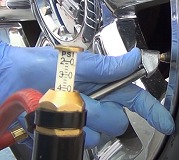Use a punch if necessary, and a hammer to pound the old pieces out. Place the new studs in their holes, then use a small stack of washers, then a lug nut turned around so the flat side is against the washers, to pull the studs in. If you're really cheap, like I am, you can find used nuts and studs in a salvage yard but in the long run when considering your time and gas money, it's usually less expensive to just buy new parts from an auto parts store. To remove a used stud, never hit on it without a nut installed part-way or you'll smash the threads. Discard that nut. Be sure the center hole in the washers is large enough so the studs don't get stuck in them.
The studs broke because the last person to put the wheels on didn't use a torque wrench. Mechanics often get blamed for breaking studs when they remove them, but it's really the last person's fault, and that's often the vehicle owner. The threads get peeled and torn when the nuts are over-tightened. That's when the damage occurs but it's not apparent until the nuts are removed next time. Most shop owners give one verbal warning when they find a mechanic not torquing lug nuts. Repeated failure usually leads to being invited to find a job somewhere else.
Look at the friction surfaces of all of the lug nuts, and the mating surfaces on the wheels. Those have to be smooth and completely free of grease because that is what holds the nuts from working loose. If either one is chewed up, replace it.
Once you have the wheels installed and the lug nuts are torqued, recheck them after a few miles because you may not have gotten the new studs pulled in all the way. The flexing wheel will do that but then the nuts will be loose. Recheck them again after a few days.
The proper torque for your vehicle is 95 foot pounds with steel wheels. It's a little less for cast wheels but I can't remember if it's 80 or 85 foot pounds.
Friday, July 25th, 2014 AT 9:01 PM



